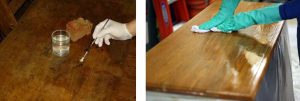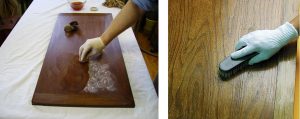Finishing
For finishing furniture after restoration or renovation it is advisable not to use sealers or paints. To regain the charm of the antique artifact it is always better to resort it with traditional products such as shellac or wax. Shellac gives a glossy and rather shiny finish; it is applied with a pad after the product has been diluted in an alcohol based solution; anilines can be added to change the original colour of the wood.
Wax provides a distinctive glossy finish but not shiny, typical of encaustic treatments. Encaustic wax refers to products treated with essence (not water based emulsifiers) which allows for both deep treatment and surface treatment of the wood, but also protect from attack by mould and termites. Furthermore with this type of treatment the wood pores are filled by the wax that, keeps the fibrils of the wood smoothed down making the surface smooth and velvety to the touch.
Encaustic treatment is one of the most beautiful and safe finishes for furniture and is made with specific products based on beeswax essence blended with other waxes, carnauba generally, diluted with turpentine. Ready to use products are available which are very convenient to prepare and apply but are not always top quality. In certain cases it has been found that the content of beeswax is only a small percentage of the product. Prior to purchasing it is always advisable to read the ingredients carefully.
Preparation of the wax mixture for encaustic is quite simple. The ingredients are beeswax, carnauba wax and turpentine. The waxes are heated on low flame – the proportion of beeswax to carnauba wax is 15% (150 grams of carnauba wax to a kilo of beeswax). When the wax has melted the flame is turned off the turpentine is added in the proportion of one litre every 250 grams of wax (of course the quantity of product to be prepared depends on the size of the surface to be treated). It should be mixed with care and left to cool. If a particular colour is desired then a normal aniline dye of desired hue can be added to the mixture. At this point the mixture can be applied on the wood using a flat brush.
Before the mixture completely dries, dab the surface with soft bees wax working it in to penetrate perfectly. The liquid solution will protect the wood in depth while the creamy wax will create a surface film that can be polished occasionally thus restoring the wooden furniture to its perfect shine.
After about 24 hours from the treatment however, just before it is perfectly dry, it is necessary to brush the surface to remove the excess wax, and then polish using a warm woollen cloth. The cloth should not leave fuzz on the surface.
Following is a list of the basic tools required to start a workshop of for wood restoration.


